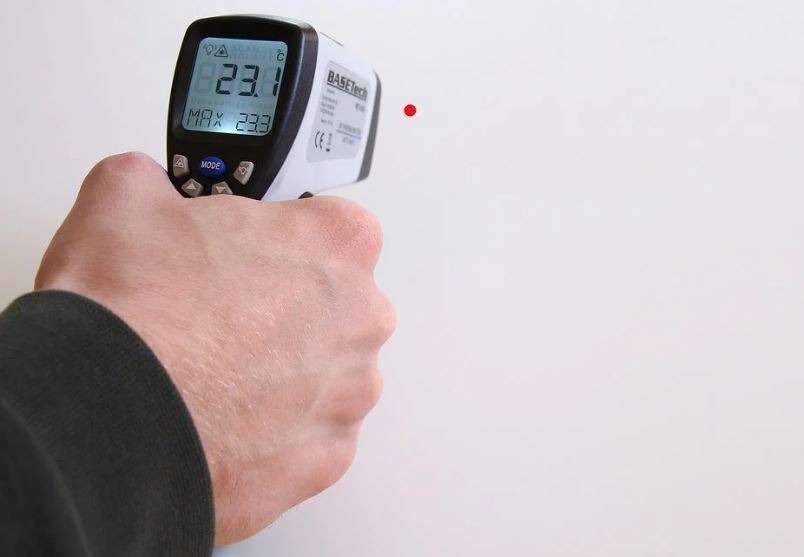Most people picture a conventional thermometer when they think of a thermometer. This type of thermometer monitors the temperature of an object by inserting itself into it. However, with the development of thermal sensing technology, an infrared thermometer arose and has been widely employed in various industries, including electrical systems and circuit boards, automotive, HVAC, culinary, industrial, and medical applications.
In the wake of the 2019-nCoV coronavirus pandemic, public health officials and medical professionals have begun to use infrared thermometers to take the temperature of large numbers of people in public locations. However, few are still unfamiliar with how infrared thermometer works.
What is an Infrared Thermometer?
A handheld infrared thermometer is used to determine the surface temperatures of an object or area without touching the thing. To obtain the surface temperature of an object without any physical touch, it uses a built-in laser. When the infrared thermometer has completed a scan of an object or area, it will display the temperature on the corresponding display panel.
Infrared temperature sensors are the most commonly used thermometer, especially if the target is impossible to reach in industrial situations where the object is too hot to approach. Industrial infrared thermometers can also check a person’s body temperature. The non-contact nature of these devices helps limit infection risk when used to measure body temperature.
How does an Infrared Radiation work?
An infrared thermometer uses thermal radiation emitted by a specific object to determine the object’s temperature. Remember that infrared energy is a type of electromagnetic radiation lower in frequency than visible light, including the human body. It is possible to emit, gather, or absorb infrared light. Infrared radiation is also emitted in higher concentrations when objects are hotter.
Using an infrared thermometer, you may make use of this unique feature. The infrared radiation is collected in a thermopile detector using a lens with a built-in laser to focus on a specific object’s infrared light emission. It is the thermopile inside the infrared thermometer, where the absorbed radiation is transformed into heat and finally into electricity. Electricity consumption is ultimately monitored and displayed on the thermometer’s display as a temperature reading.
What are the Things to Consider When Selecting an Infrared Thermometer?
1. Accuracy
The most critical component of a thermometer is accuracy; it is the only indicator of the infrared thermometer’s performance. Accuracy is typically represented as a difference of X degrees Celsius or X percentage points. Distance-to-spot (D/S) ratio determines infrared thermometer accuracy. This ratio specifies the thermometer’s maximum distance from a surface. Using an IR thermometer with a D/S ratio of 8:1, you can measure the surface temperature of a 4-inch area from 32 inches away (8:1 x 4). This means that larger proportions allow you to gauge temperature from a greater distance. Distance increases surface area.
2. Emissivity
Emissivity is the ratio of an object’s temperature-specific radiation to that of an ideal radiator at that temperature. Emissivity measures a thermometer’s infrared output; varying surfaces have various emissivity. Others have an adjustable emissivity of 0.95. IR thermometers with higher emissivity can read more materials. The infrared thermometer’s emissivity can be modified to ensure accurate measurements. Pick a thermometer with an adjustable emissivity level to change the quantity of infrared energy emitted and correct for energy reflected by the material being measured.
3. Temperature Range
An infrared thermometer’s temperature range impacts its performance. It is possible to record a wide range of actions at varying temperatures using an IR thermometer. However, it is recommended to use an infrared thermometer with a small temperature range to achieve greater temperature control precision in the specific process under consideration.
4. Reading Speed or Response Time
Reading speed is how quickly a thermometer gives an accurate reading after being started. This factor is essential when measuring a moving object’s temperature or when it heats up quickly. Response time is how fast an infrared thermometer reaches 95% of its final reading. It’s how quickly the infrared thermometer responds to temperature fluctuations. The new infrared thermometer response time is 1ms. If the object moves quickly or is heated rapidly, choose a fast-responding infrared thermometer; otherwise, the measurement accuracy will be reduced.
5. Design
IR thermometers for industry must be durable. It is safe to use no-lens and Fresnel lens thermometers because of their polymer structure. Tough Mica lens thermometers need a sturdy housing and carrying cover to protect the lens from cracking.
The Benefits of Using an Infrared Thermometer
Why use infrared thermometers? How can they measure body temperatures? Are infrared thermometers better than regular probe thermometers? Here are some infrared thermometer benefits to help you decide.
1. Conveniently portable
Lightweight infrared thermometers are portable. They resemble firearms, making them comfortable to hold. Also, they’re simple to use in seconds. Most infrared thermometers have memory, making it easier to record many temperature readings at once.
2. Accurate temperature readings
Infrared thermometers measure surface temperatures instantly. Quick temperature readings allow the infrared thermometer to measure huge groups of people in airports and train stations. The infrared thermometer gives precise readings with a measuring inaccuracy of 2.0 percent. Many infrared thermometers allow you to alter emissivity, allowing for more accurate temperature measurement.
3. Non-contact measurement non-contamination
Non-contact infrared thermometers offer remote temperature readings. An infrared Thermometer is handy for monitoring high-temperature surfaces that can’t be touched or detecting out-of-reach things. Infrared thermometers can detect temperatures without touching the mouth, armpit, or rectum. Lack of contact leads to reduced or no possibility of contamination, allowing for quicker and benign use in airports, train stations, and border crossings.
4. Multipurpose
Infrared thermometers are useful for detecting automobile faults, diagnosing heat-related HVAC problems, testing food safety, monitoring manufacturing products for quality assurance, and measuring the body temperature of humans.
5. Moving object measurement
Thermometers with built-in lasers can measure moving things. In assembly areas like airports, infrared thermometers can monitor people without stopping. It makes measuring quick and efficient, preventing travel delays.
Infrared thermometers scan and photograph thermal radiation to display data. It’s a quick and accurate way to measure temperature, the built-in laser measures the surface temperature of an object based on its thermal radiation. It’s a powerful temperature-detection gadget used in non-contact applications. The infrared thermometer is another innovative invention brought about by constantly evolving technology.




